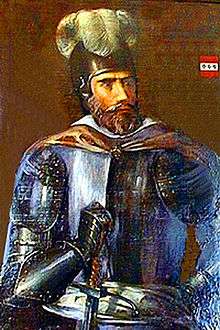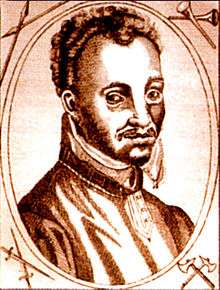François de Beaumont
François de Beaumont, baron of Adrets (c. 1512/1513 – February 2, 1587) was a leader (capitaine dauphinois) of the Huguenots in the religious wars of The French Reformation. Known for his cruelty in action, he was a supporter of the Protestant troops, then changed sides in 1567 to join the Catholics.[1][2]

Biography
He was born in 1512 or 1513 at the château of La Frette (Isère). [In other version, he was born around 1506 in the fortified house of his father in Villard-Castle, in the town of Adrets.] He was the son of Georges de Beaumont, baron of the Adrets and Jeanne Guiffrey.[3] He married Claude Gumin with whom he had several children. None of his son survived him. One of them was killed at the siege of La Rochelle in 1573. His two girls had only one offspring.
During the reign of Henry II of France he served with distinction in the royal army and became colonel of the legions of Dauphiné, Provence and Languedoc. From 1525 to 1559, he waged war in Italy, where he distinguished himself by his bravery under the orders of Marshal Brissac. He was taken prisoner in 1558 by the Spaniards in Moncalvo and must pay ransom to free himself. In 1562, however, he joined the Huguenots, not from religious conviction but probably from motives of ambition and personal dislike of the house of Guise.[4]
Career

His campaign against the Catholics in 1562 was eminently successful. In June of that year Des Adrets was master of the greater part of Dauphiné. But his brilliant military qualities were marred by his revolting atrocities. The reprisals he exacted from the Catholics after their massacres of the Huguenots at Orange have left a dark stain upon his name. The garrisons that resisted him were butchered with every circumstance of brutality, and at Montbrison, in Forez, he forced eighteen prisoners to throw themselves from the top of the keep. Having alienated the affections of the Huguenots by his pride and violence, he entered into communication with the Catholics, and declared himself openly in favor of conciliation.[4] Following the defeat of the Protestant armies in Cahors, Amiens, Sens and the massacre of Wassy face Guise in March 1562, he took command in April of Protestants of Provence, and enters Valencia with 8000 men. From that moment and blazing overlapped, he routed the enemy in Romans-sur-Isère, Grenoble and Vienna where he plundered the Cathedral Saint-André and Notre-Dame de Grenoble. On 5 May 1562, he returned victorious in the city of Lyon.[5] After Feurs in Forez, July 3, he marched on Montbrison at the head of four thousand, and seized the town 14 July 1562.
He then went directly to the castle of Montrond, where the governor of Forez was entrenched. He enters the city the next day; then, leaving Quintel, one of his lieutenants, retired to Lyon where there was a massacre. At Montrond he plundered the church; and the chronicle says that because they were too slow to bring him the sacred vessels, he threw the priest and the churchwarden from the belfry.
This way of making war displeases Calvin. On July 17, he was replaced in Lyon, as Lieutenant General, by Soubise. Also this type of terror enrages the papal troupes who go on to commit reprisal atrocities.[6][7]
In November, he met the Duke of Nemours, besieged in Vienna, who offers him the title of governor of the Dauphiné. But in December the Condé vacated the office.
Having fallen behind, and touched by remorse, Baron then left the Protestant religion and returned to Catholicism. In 1564, Baron of Adrets, to take some Protestant strongholds and advises Claude La Châtre, governor of Berry, to withdraw. In 1567, he returned to war alongside the lieutenant general of Dauphiné, Bertrand de Gordes, under the banner of catholiques.[8] Two years later he returns to the country, but his foot was crushed in Selongey. Finally, in the Trièves, he won his last battle against Lesdiguières.
Last days
On 10 January 1563 he was arrested on suspicion by some Huguenot officers and confined in the citadel of Nîmes. He was liberated at the edict of Amboise in the following March, and, distrusted alike by Huguenots and Catholics, retired to the château of La Frette.[4] In 1585, in league with the Englishman Richard Topcliffe, he attacked and ransacked the Abbey of Our Lady of Aiguebelle, Provence, and attempted to destroy it. Unable to do so, he buried all entrances to the Abbey beneath tons of earth and rubble. He died in bed on February 2, 1587 in his castle of La Frette. The place of his burial is not known.[4]
References
- Jules Courtet, Dictionnaire géographique, géologique, historique, archéologique et biographique du département du Vaucluse, Christian Lacour, Nîmes (réed.), 1997 p 317.
- Selon Paul Dreyfus dans Histoire du Dauphiné, page 145.
- Arlette Jouana, Histoire et dictionnaire des guerres de religion, Robert Laffont 1998, p. 636
-

- J. Roman, Documents inédits sur le baron des Adrets (1878); and memoirs and histories of the time
- Guy Allard, Vie de François de Beaumont (1675)
- l’abbé J. C. Martin, Histoire politique et militaire de François de Beaumont (1803)
- Eugène and Émile Haag, La France protestante (2nd ed., 1877 seq.)
- Patrice Béghain, Bruno Benoît, Gérard Corneloup, Bruno Thévenon (coord.), Dictionnaire historique de Lyon, Lyon, Stéphane Bachès, 2009, p1054.
- Robert Bailly, Dictionnaire des communes du Vaucluse, A. Barthélemy, Avignon,, 1986 p412.
- Jacques-Auguste de Thou , Histoire universelle, Volume 3 (H. Scheurleer, 1740)https://books.google.fr/books?id=QdIWAAAAQAAJ&printsec=frontcover&hl=fr&source=gbs_ge_summary_r&cad=0 p412 .
- Selon Paul Dreyfus dans Histoire du Dauphiné, (Hatchet, 1976) page 145.